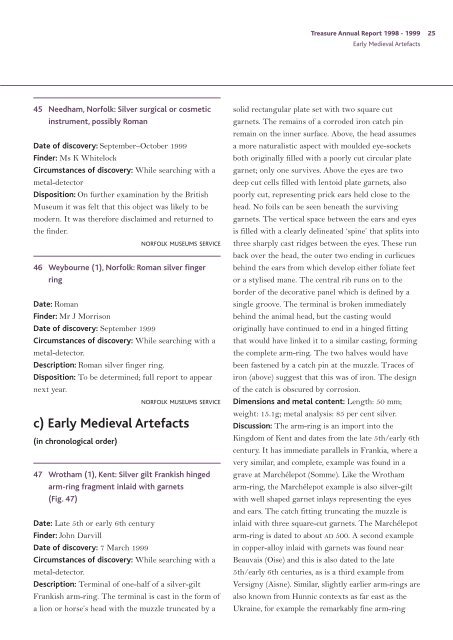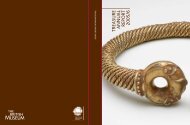Treasure Annual Report 1998-1999 - Portable Antiquities Scheme
Treasure Annual Report 1998-1999 - Portable Antiquities Scheme
Treasure Annual Report 1998-1999 - Portable Antiquities Scheme
You also want an ePaper? Increase the reach of your titles
YUMPU automatically turns print PDFs into web optimized ePapers that Google loves.
45 Needham, Norfolk: Silver surgical or cosmetic<br />
instrument, possibly Roman<br />
Date of discovery: September–October <strong>1999</strong><br />
Finder: Ms K Whitelock<br />
Circumstances of discovery: While searching with a<br />
metal-detector<br />
Disposition: On further examination by the British<br />
Museum it was felt that this object was likely to be<br />
modern. It was therefore disclaimed and returned to<br />
the finder.<br />
NORFOLK MUSEUMS SERVICE<br />
46 Weybourne (1), Norfolk: Roman silver finger<br />
ring<br />
Date: Roman<br />
Finder: Mr J Morrison<br />
Date of discovery: September <strong>1999</strong><br />
Circumstances of discovery: While searching with a<br />
metal-detector.<br />
Description: Roman silver finger ring.<br />
Disposition: To be determined; full report to appear<br />
next year.<br />
NORFOLK MUSEUMS SERVICE<br />
c) Early Medieval Artefacts<br />
(in chronological order)<br />
47 Wrotham (1), Kent: Silver gilt Frankish hinged<br />
arm-ring fragment inlaid with garnets<br />
(Fig. 47)<br />
Date: Late 5th or early 6th century<br />
Finder: John Darvill<br />
Date of discovery: 7 March <strong>1999</strong><br />
Circumstances of discovery: While searching with a<br />
metal-detector.<br />
Description: Terminal of one-half of a silver-gilt<br />
Frankish arm-ring. The terminal is cast in the form of<br />
a lion or horse’s head with the muzzle truncated by a<br />
<strong>Treasure</strong> <strong>Annual</strong> <strong>Report</strong> <strong>1998</strong> - <strong>1999</strong> 25<br />
Early Medieval Artefacts<br />
solid rectangular plate set with two square cut<br />
garnets. The remains of a corroded iron catch pin<br />
remain on the inner surface. Above, the head assumes<br />
a more naturalistic aspect with moulded eye-sockets<br />
both originally filled with a poorly cut circular plate<br />
garnet; only one survives. Above the eyes are two<br />
deep cut cells filled with lentoid plate garnets, also<br />
poorly cut, representing prick ears held close to the<br />
head. No foils can be seen beneath the surviving<br />
garnets. The vertical space between the ears and eyes<br />
is filled with a clearly delineated ‘spine’ that splits into<br />
three sharply cast ridges between the eyes. These run<br />
back over the head, the outer two ending in curlicues<br />
behind the ears from which develop either foliate feet<br />
or a stylised mane. The central rib runs on to the<br />
border of the decorative panel which is defined by a<br />
single groove. The terminal is broken immediately<br />
behind the animal head, but the casting would<br />
originally have continued to end in a hinged fitting<br />
that would have linked it to a similar casting, forming<br />
the complete arm-ring. The two halves would have<br />
been fastened by a catch pin at the muzzle. Traces of<br />
iron (above) suggest that this was of iron. The design<br />
of the catch is obscured by corrosion.<br />
Dimensions and metal content: Length: 50 mm;<br />
weight: 15.1g; metal analysis: 85 per cent silver.<br />
Discussion: The arm-ring is an import into the<br />
Kingdom of Kent and dates from the late 5th/early 6th<br />
century. It has immediate parallels in Frankia, where a<br />
very similar, and complete, example was found in a<br />
grave at Marchélepot (Somme). Like the Wrotham<br />
arm-ring, the Marchélepot example is also silver-gilt<br />
with well shaped garnet inlays representing the eyes<br />
and ears. The catch fitting truncating the muzzle is<br />
inlaid with three square-cut garnets. The Marchélepot<br />
arm-ring is dated to about AD 500. A second example<br />
in copper-alloy inlaid with garnets was found near<br />
Beauvais (Oise) and this is also dated to the late<br />
5th/early 6th centuries, as is a third example from<br />
Versigny (Aisne). Similar, slightly earlier arm-rings are<br />
also known from Hunnic contexts as far east as the<br />
Ukraine, for example the remarkably fine arm-ring





